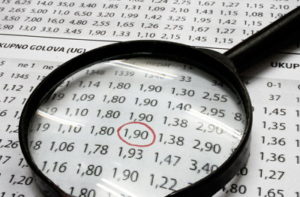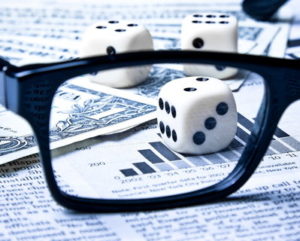 Bookmakers have margins cut into their odds, which is how they are pretty much able to guarantee themselves a profit. These odds are often referred to as ‘implied odds’, as opposed to ‘true odds’ which are the odds without a bookie’s take added into them. In other words, if you were to toss a fair coin then the true odds of it being either heads or tails would be Evens, 1/1. If you were to ask a bookmaker to offer odds on the outcome of a fair coin’s toss, the likelihood is that they’d give you worse odds in order to add their margin, something like 10/11.
Bookmakers have margins cut into their odds, which is how they are pretty much able to guarantee themselves a profit. These odds are often referred to as ‘implied odds’, as opposed to ‘true odds’ which are the odds without a bookie’s take added into them. In other words, if you were to toss a fair coin then the true odds of it being either heads or tails would be Evens, 1/1. If you were to ask a bookmaker to offer odds on the outcome of a fair coin’s toss, the likelihood is that they’d give you worse odds in order to add their margin, something like 10/11.
In betting, the trick is to find markets in which the bookmaker’s odds are bigger than the true odds, for that is where the value lies. This, of course, takes a huge amount of research, to say nothing of the fact that most punters will never really know what the true odds of an event really are. You can get close, though, and it is upon doing so that you’ll find yourself in a situation where you will be more likely to win a bet than if you hadn’t done your research and had instead just gone with your instinct for a given wager.
Implied Probability Explained
 Whether you’re looking at betting on individual matches, In-Play betting markets or coming up with an accumulator of various different games, understanding implied probability is important to bettors. Implied probability involves converting odds into a percentage in order to try to figure out what the bookmaker’s margin is. By doing so, you can then remove the margin and put yourself in a situation where you can figure out the true probability of a certain outcome, which in turn will allow you to discover of there is value in the bet.
Whether you’re looking at betting on individual matches, In-Play betting markets or coming up with an accumulator of various different games, understanding implied probability is important to bettors. Implied probability involves converting odds into a percentage in order to try to figure out what the bookmaker’s margin is. By doing so, you can then remove the margin and put yourself in a situation where you can figure out the true probability of a certain outcome, which in turn will allow you to discover of there is value in the bet.
In sports betting, the fact that a bookmaker’s edge is included in the odds that they offer means that the implied probability of said event will always add up to more than 100%, with the figure over the 100% mark being the bookie’s margin. By being able to convert betting odds into their implied probabilities, we can assess how much value there is in a wager and even whether or not the bookmaker has got it wrong. Using an example of a match between Chelsea and Everton on the draw no bet market, let’s imagine that the decimal odds were as follows:
- Everton: 13.0
- Draw: 6.0
- Chelsea: 1.22
It is clear that, in this example, the bookie in question feels as though Liverpool are overwhelming favourites. We then get the implied probability by dividing 1 by each of the prices in turn and multiplying by 100:
- Everton: 1/13 x 100 = 7.69%
- Draw: 1/6 x 100 = 16.66%
- Chelsea: 1/1.22 x 100 = 81.97%
Adding those three together, we get an outcome of 106.32%, meaning that the bookmaker’s margin is 6.32%. This means that if the bookie gets an equal proportion of bets on all outcomes (a balanced book) they can guarantee to make £6.32 for every £100 staked.
True Probability
 The biggest problem when it comes to discussing implied and true probability is that it is not very common for the true probability to ever be known when it comes to sports betting. As a result, it has to be estimated, which obviously makes things slightly trickier when it comes to figuring out where the value is in bets. Fair odds are ones in which no one makes a profit in the long-run, on account of the fact that the loser ends up paying the winner. That is why bookies add in their margin, so that in the long-run they make a profit.
The biggest problem when it comes to discussing implied and true probability is that it is not very common for the true probability to ever be known when it comes to sports betting. As a result, it has to be estimated, which obviously makes things slightly trickier when it comes to figuring out where the value is in bets. Fair odds are ones in which no one makes a profit in the long-run, on account of the fact that the loser ends up paying the winner. That is why bookies add in their margin, so that in the long-run they make a profit.
Bookmakers constantly look to adjust their odds so that the losers pay the winners and the company makes a profit. They do this by trying to ensure that the same proportion of money is bet on all possible outcomes, which happens when they make what should be an unappealing wager more appealing to those that are watching. Equally, if the odds on a dead-cert to win are low enough, the amount they’ll have to pay out will be low enough to mean that they can cover it with the money paid on the losing outcome on the bet in question.
Let us go back to our coin flip example to explain what we mean. In that situation, a bookmaker would offer odds of 1.95 on heads and the same odds on tails, with the decimal odds used as it makes it easier to understand. With 2.00 being the equivalent of Evens, it means that the loser still pays with the winner but the extra 0.05 goes to the bookie and guarantees them their profit. Bookmakers will look to increase their margin if they don’t have enough bettors as this will allow them to cover their risk more readily.
By working out the true probability of an event, or a close approximation of it, we can figure out if the bookies have got their odds wrong. If we think, for example, that the coin being used is actually weighted more readily to land on heads than tails, we can be bet on heads and win more often than we’ll lose. Clearly we’re unlikely to get to bet on a coin toss very often, but swap the coin for a feeling that the bookmakers have under-estimated the ability of one side to win over another and you’ll see the sort of thing that we’re talking about.
Compare Bookies
 It is always important to get the odds of a few different bookmakers, but that is especially true when we’re trying to figure out if any of them have got their implied probability wrong. Each bookie will have a different amount of money bet on each outcome, meaning that they’ll need to adjust the odds that they’re offering in order to cover their liability. On top of that, each bookmaker will have their own margin that they’ll be trying to reach, so the odds will reflect that fact. That opens up the chance of an incorrectly priced margin with one of them.
It is always important to get the odds of a few different bookmakers, but that is especially true when we’re trying to figure out if any of them have got their implied probability wrong. Each bookie will have a different amount of money bet on each outcome, meaning that they’ll need to adjust the odds that they’re offering in order to cover their liability. On top of that, each bookmaker will have their own margin that they’ll be trying to reach, so the odds will reflect that fact. That opens up the chance of an incorrectly priced margin with one of them.
Shopping around is sensible at the best of times, but with bookies simultaneously looking to compete with each other as well as get their own margins in play, there’s no question that you could find a pricing error if you know what you’re looking for. Having a good sense of the true probability of an outcome as well as being able to work out the implied probability will mean that you can look across the odds of several bookmakers and know whether or not there is some value to be found with any of them.
Another option is to look at exchanges. Here betting is done peer-peer with the ability to back markets like you would with a traditional bookie but also lay bets to other people, in effect acting like your own mini-bookie. When you have large sample sizes of people predicting something often it produces an incredibly accurate reflection of the true odds – e.g. when you get thousands of people to predict how many jelly beans there are in a jar the average is often very close to the real value. See what odds exchanges are offering and compare these to the bookies.
